 |
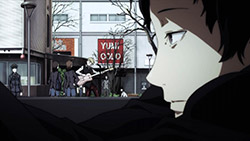 |
 |
 |
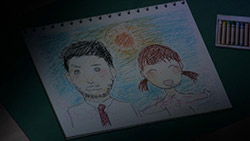 |
 |
 |
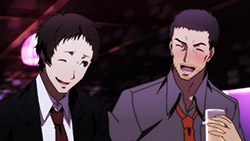 |
 |
 |
 |
 |
 |
 |
 |
 |
 |
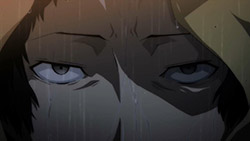 |
 |
 |
 |
 |
 |
 |
 |
 |
 |
 |
 |
 |
 |
 |
 |
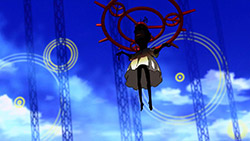 |
 |
 |
「See? I told you Yu.」
Let’s ignore Marie’s existence for a moment. Just for a change of pace. Let’s sit down, get serious for a spell, and talk about Adachi.
This week is the expected Adachi episode and it’s just the kind of thing we’ve been needing; nothing gets a plot running like a good villain. I suppose that begs that question: is Adachi a good villain? Without a doubt, Adachi is a villain. He’s a misogynist, a narcissist and a sociopath. At the very least he’s the ‘Bad Guy’ responsible for the ‘Bad Things’. But the issue is, of course, whether or not he ends up being compelling.
In stories, the villain serves to shake the status quo and is a mover of the narrative; you might have heard of the old adage about how the villain acts and the hero reacts. A good villain is also often the hero’s foil. That is, they are contrasting characters who highlight certain qualities in each other. Adachi plays that part well. If there’s one thing about the original Persona 4 adaptation I’d disagree with it would be giving Yu a Shadow. Yu doesn’t need a Shadow; Adachi is his Shadow, or at least negative aspects of the Fool that Yu comes to terms with. The dichotomy is really played up in the Golden ANIMATION. Yu seeks out connection with other people; Adachi actively rejects it. When asked by Nanako what to plant in the herb garden Yu is fine with whatever Nanako likes; Adachi suggests cabbage, which he likes. And look at this light/shadow symbolism! Just in case we didn’t get it.
Interestingly, this episode does not attempt to explain exactly how Adachi got this way, only that he is. Perhaps it’s a comment on the innate nature of personalities. Perhaps Adachi’s behaviour simply cannot be sympathised with. Perhaps we just haven’t gotten to it. Whatever the case may be, the focus is on the little excursion we take inside Adachi’s head. It’s not a happy place. Adachi wants to be a special little snowflake and secretly enjoys attention. He doesn’t care about others but wants others to care about him. He wishes for success but doesn’t wish to work for it. His failures are never his own fault. This twisted personality drives Adachi to nihilism. Or perhaps his nihilist philosophy made him twisted? The chicken or the egg?
Compared to his portrayal in the first anime or the game Adachi in the Golden ANIMATION is significantly darker. It is easy to forget that, despite Persona 4‘s bright colour palette and light-hearted optimism, the mystery being solved is about cold-blooded murder. P4GA reminds us of the brutality with small doses of horror as it evokes imagery of drowning and, perhaps unavoidably, sexual assault. But perhaps the most chilling is Adachi’s reaction to his own violence. Adachi may be a Jester and play the clown, but clowns can be terrifying in their own way. Like Batman’s nemesis the Joker or Final Fantasy 6’s Kefka, Adachi’s reaction to murder is hysteria. There’s no surer sign that you’ve gone over the edge. But, hey, sometimes all you can do is laugh.
Reading the cards
Although Marie did make her contractual appearances this week her overall absence from the episode was…rather refreshing. I suppose technically speaking the rest of the Investigation Team appeared even less but Adachi is a welcome understudy. It is in the nature of psychopaths to be irresistible. It makes one wonder whether, in the Adachi Social Link as shown in P4GA, Yu was genuinely interested in Adachi or drawn in by his outward persona.
As noted, P4GA does not try to paint Adachi as a sympathetic antagonist in any way, which is not a flaw per se. Sometimes a villain is nothing but malevolence to serve as that dark abyss of humanity that we sometimes must gaze into. And for Yu, who has gazed long indeed, the abyss gazes also into him. Of course, we know that Yu will eventually shake this devil off his shoulder but right now he is at his most vulnerable and, as such, this is as poignant as Persona 4 gets. Suitably, next week seems to feature the confrontation between Yu and Adachi; the clash between hero and villain is another essential trope in this journey.
Since we’re only half-way through the anime I hope we won’t be done with Adachi just yet. He made for a better antagonist than the giant eyeball or warped deity, perhaps because Adachi is still, in the end, human. His evil is a very petty, selfish evil and therefore, on some level, relatable. And it isn’t like Persona to let Adachi go without developing his Freudian excuse.
Preview
 |
 |
 |

Seeing Adachi doing his dirty work animated did look more scary than in the game for me, especially because of that face he makes. I can only guess it’s an unpleasant upbringing that made Adachi into what he is. Show Spoiler ▼
It’s like watching the dissection of evil. You’re hoping him to be decent but he disappoints you with his bouts of insanity…
HEY YOU! DANCE WITH ME
Yes.
Concerning how Adachi became the way he is, if you guys played through the story mode of Persona 4 Arena, it actually gave us a pretty big revelation during Mitsuru’s story mode near the beginning.
Adachi’s name was never thrown out but it was obvious it was him through the voice actors alone. I think it was a very good addition of detail.
The decision to give Adachi a social link in the Vita’s P4G was what really made me love the updated port more than the original game. In the same vein, fleshing out Adachi’s story makes me prefer P4GA over the first anime.
Adachi is such a cliche
I don’t think it’s ever good to get too hung up on originality because, frankly speaking, nothing is new under the sun. More often it is the execution that will carry the character.
(That said, just because Adachi may not be entirely original doesn’t necessarily make him a ‘cliche’, but that’s another discussion for another time.)
He’s talking about the preview. It’s cliche, so what?
I get the distinct impression that the line is actually Yu’s, but I could be wrong. Regardless, my point stands.
Adachi is indeed pretty cliche, but this episode was great regardless. This anime is doing surprisingly well for me.
My Adachi murder face quota is fulfilled.
What if Adachi is actually vegetarian and all of Yuu’s bento had meat in them. He couldn’t eat them even though he was hungry. Everything is Yuu’s fault